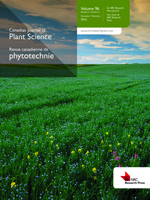Boersma, J. G., Hou, A., Gillard, C. L., McRae, K. B. and Conner, R. L. 2015. Impact of common bacterial blight on the yield, seed weight and seed discoloration of different market classes of dry beans (Phaseolus vulgaris L.). Can. J. Plant Sci. 95: 703-710. Common bacterial blight (CBB) is a seed-borne disease of dry bean (Phaseolus vulgaris L.), causing significant economic loss to growers due to reductions in seed yield and quality and the need to annually purchase disease-free seed. Over the past decade a number of breeding lines and cultivars with resistance to CBB have been developed in several bean market classes including navy, black and cranberry beans. A comparison of three susceptible navy bean cultivars and seven resistant navy, three black and one cranberry bean entries in Manitoba revealed that most resistant navy and black bean lines had significantly reduced the incidence of leaf symptoms and their mean yield losses were reduced to less than 17%, while those of the susceptible lines were as high as 36% under severe disease pressure. Only the weakly resistant navy bean cultivar HR67 and the cranberry bean line F4GR1 failed to substantially reduce CBB symptoms or show a yield advantage. The Simple Sequence Repeat (SSR) marker PVctt001 in combination with Sequence Characterized Amplified Region (SCAR) marker SU91 was associated with a low incidence of CBB symptoms and a reduced yield loss in five navy bean lines, but not in the cranberry bean line F4GR1. Disease symptoms on the pods in the resistant black and navy beans and seed discoloration of navy beans caused by CBB were also significantly reduced by resistance. Seed weights were reduced by 2.1-4.7% in the susceptible cultivars, but there was only a slight or no decrease or no effect on the seed weight of the CBB-resistant lines and cultivars. Generally the magnitude of the reductions in yield was much greater than the impact on seed weight, which suggests that yield losses were caused by a combination of reduced seed weight and the number of seeds per plant.
How to translate text using browser tools
19 March 2015
Impact of common bacterial blight on the yield, seed weight and seed discoloration of different market classes of dry beans (Phaseolus vulgaris L.)
J. G. Boersma,
A. Hou,
C. L. Gillard,
K. B. McRae,
R. L. Conner
ACCESS THE FULL ARTICLE
It is not available for individual sale.
This article is only available to subscribers.
It is not available for individual sale.
It is not available for individual sale.

Canadian Journal of Plant Science
Vol. 95 • No. 4
July 2015
Vol. 95 • No. 4
July 2015
brûlure bactérienne
common bacterial blight
décoloration des semences
Phaseolus vulgaris
Phaseolus vulgaris
poids des semences
rendement




